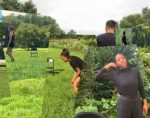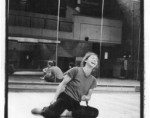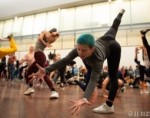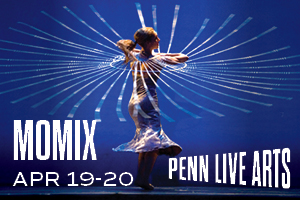Dance/UP Showcase: A Presenter’s Thinking, Exposed
by Lisa Kraus
Most dance artists hate showcases, the kind where everyone has 15 or 20 minutes to spread out their wares in a big dance supermarket.
I started appreciating them when I became the coordinator of a performing arts series and they were an efficient way to learn about the work of lots of artists in a short time. The Association of Performing Arts Presenters conference (APAP) each January in New York is a gluttonous feast of such showings, and that’s in large part why presenters come from all corners of the globe. They take in as much as possible, then contact booking agents and work out who will appear on upcoming seasons.
So with the substantial activity of Philadelphia’s dance scene and the work of 22 artist/companies on the menu this year, plus five in a “Show-and-Tell” and additional evening shows over the course of two days, why didn’t more out-of-town presenters show up for the fifth annual DanceUSA/Philadelphia (Dance/UP) showcase? Judging from the materials I received, I think Dance/UP reaches out effectively. Lois Welk, its director, told me that she works hard to encourage attendance. The majority of presenters came from South Arts Dance Touring Initiative, a group which is subsidized to travel together to see dance. Where were the regional presenters with a big dance profile: the Walker Art Center, White Bird in Portland, Columbia Dance Center in Chicago? And even if New York presenters can come easily to watch a full show, why wouldn’t they take the pulse of Philadelphia’s dance in these showcases? Presenters have an effective grapevine. If a dance company or a community is on one’s radar, likely there will be buzz getting more presenters interested. Has word gotten out that the work at the showcase isn’t worth the trip? Why isn’t the sweep of dance represented in the Philly showcases grabbing the interest of more “shoppers”?
Welk told me that in the five years of running this showcase, it has helped two artists sign with agents and resulted in six bookings (including one international performance opportunity) and one residency. While every invitation and connection is important, these numbers are surprisingly low. Why aren’t more presenters hiring artists seen in the showcases?
I saw issues in the work on view that I feel can, at least in part, explain what’s going on. Wearing my presenter hat, I took notes on each of the performances and Show-and-Tell presentations (which, rather than showings of actual work, were explanations illustrated with video clips). Those notes are shown here in italics. Then I chewed on it all some more. What makes a dance appealing to presenters? For those, like me, who look for work that’s excellently danced, interestingly conceived and well-crafted, my sense is that few of the groups delivered all three at once. Below are some of the reasons, along with some of what I am looking for.
(In an effort to bring attention to broader principles, I felt that naming artists, particularly where my critique is sharp, would be a distraction, so I’ve chosen to omit all names.)
THE DANCERS
Watching dance performance is watching human beings. How do we perceive them? I love to see terrific skill combined with full focus and presence but without the performers seeming puffed up. It’s a delicate line, like Goldilocks’ “too hot… too cold…just right!”
A possible disadvantage of the showcase format is that dancers feel an imperative to impress in their short window onstage and overdo in a misplaced attempt at getting work. The drive in performers’ energy was at times overwhelming. I am always feeling out for myself whether the performers convey authenticity. Do I believe them? Are they whiz kids trying to make me gasp or is there something deeper going on? These performers seemed like caricatures of dancers: pumped up, displaying their impressive tricks or speed. I missed nuance and depth. In a culture where louder, stronger, faster, brighter are endlessly seductive, it’s work that modulates those qualities and uses them with intention that comes across most powerfully.
Quality of presence is a choreographer’s aesthetic choice, one that will not please all the people all the time. I am so turned off to the meaningfulness with which this dance is performed. The dancers approach it as if it was a sacred rite, and I do not feel brought along. Why is their performing presence cartoonishly overdrawn? While the performers’ feelings about a piece may be genuine, their transmission of that intensity may not appear to be. Either through unconvincing acting or by applying heavy artillery to a small target, the performing can read as soap opera. Granted there are certain cultures where the convention favors more rather than less, so both culturally-shaped taste and skill figure here.
Some performers play deliberately with presence. There’s something attractive and repulsive about her way of presenting herself in performance, as a person who goes to the edge of narcissism and grotesque parody. And some manage to hit a sweet spot: I am delighted that this solo dancer, who has introduced his work as being connected to deliverance from an earlier life of privation and challenge, is dancing in such a straightforward, big-hearted way. He is not on Dancing with the Stars although his skill level could put him there. He is here, with us, sharing what he loves.
When a soloist is vulnerable but strong at the same time, I feel invited into the experience of watching in a way that keeps me attentive and empathetic. James Waring was right when he said “The best dancers are translucent; you can see right through them.” That kind of luminous transparency applies to everything— mental states, intentions, the dancer’s own physical experience of the in-the-moment action. It’s a generous quality of sharing everything, as Deborah Hay said—“inviting being seen.” Giving your all with ego quieted.
There are dancers whose physical sensitivity and responsiveness makes them riveting. Some of the dancers let the moves ripple all through their torsos and I am most attracted to those. They fulfill whatever kind of dance they’re doing with skills specific to that style. Others less so: I wish the dancer’s steps and rhythms were more precise. Or: their movement language is too familiar and not well-enough executed. The fact is that with certain forms proliferating on YouTube and Vimeo, folks who are truly virtuosic are easy to see, so we compare what’s onstage to the stellar ones onscreen.
THE PLATFORM
No question, short showings are a challenge. No one has enough tech time and the space may not show the work to best advantage. Still, how choreographers use that platform—what they present and how they speak about it—is a tip-off to developed artistry and the ability to work effectively within specific constraints. With a verbal intro or commentary and a limited selection of dancing, the artist’s curation and presentation of his/her own work is telling. Balancing one live onstage dancer with projected images of the actual piece—I think the artist chose well in representing the work this way.
The platform is a sales pitch. Those who come across as genuine manage it best. I loved the freshness and unpretentiousness in her delivery. What will she do next? This artist’s trajectory feels like an adventure.
The intro can make everyone in the audience an insider. The artist is at home in the space, easy and communicative. He breaks down, describes and names his moves. Watching them next in the danced sequence is fun.
Turn-offs? Over-confident authority. Using a lot of words to say nothing. People having lots of ideas about what they are doing with their dances that don’t necessarily translate into an experience the viewer shares. Or wanting too much to please, opting for something vapid or cute which may not reflect the potential of the group.
THE AESTHETICS
Some venues prize more traditional forms, or more readily accessible, entertaining ones. What’s “good” to each presenter depends on the venue, the audience profile, the adventurousness of the curation. Some want to be showing what’s at the edge of innovation. I represent a venue that might show any kind of dance: what matters is less the form than how it’s approached. But forms that are very familiar may be at a disadvantage—so much excellent work has gone before. It’s inevitable that we measure what is in front of us against what’s already been seen.
…the choreography is hackneyed… dated and turgid…a stereotypical skit-like dance.
If work is full of recognizable materials and structures, I want to feel that it’s being interrogated, that the choreographer is deliberate, skilled in creating stage pictures, using the strengths of the dancers and developing the material rigorously. What arises should be coherent and fresh rather than a rote repetition of a stale, all-too-familiar thing.
Being at the edge of developing forms can be a plus. Presenters, like all kinds of consumers, are definitely looking for the next new(/old) thing that seems a departure from what’s gone before. Integrating new media skillfully, as one group did at the showcase, is in that category. Being in tune with current cultural developments can be a plus too. At the last APAP one work drew a great deal of attention—a contemporary piece by a Native American choreographer addressing that heritage and using large fish as a prop for some stunning promotional photos.
In a related vein, I was impressed with one artist’s dance of birds to early John Cage music (he was using Balinese gongs at that time). With a movement language derived in part from Balinese dance, it intelligently fused western and Balinese aesthetics. In the end, what compels me to take notice is work that delivers a strong or unusual stage picture, no matter the aesthetic, along with some quality of newness or unpredictability. With another artist: Suddenly there she was, in a t-shirt with circles cut out for her tits, and spangly gold pants, repeating exactly what she had shown us earlier.
THE CONTENT
WHAT QUESTIONS IS IT ASKING?
Scholar/writer Tommy DeFrantz urged thINKingDANCE writers to frame their assessments of work by posing this question, taking the writer beyond like/dislike/comparison/description. The question “what does it mean?” may be less relevant in watching dance today than “what is the maker asking?”
The artist brought us up to the present moment in the evolution of his work, one addressing both queer performance and primate research. Although his presentation didn’t spell out the questions he’s posing, I intuit that the work’s mashing up of these two areas of investigation, centering on “dances” of communication, would be fascinating.
What if the watcher doesn’t feel the dance maker is chewing on substantive questions? Perhaps the artist is occupied with a specific kind of virtuosity only. Perhaps the issues addressed in the work are so personal that the choreographer hasn’t zoomed out to reflect on larger questions it raises. Or perhaps he or she takes forms and ideas as a given without much reflection. All of these can work against our becoming fully engaged. I don’t sense much depth there, or irony or critical distance—is that why I am not at all drawn in?
I often wonder what is the work saying about us and the world we are in: …someone with big talent always seeming to make something impenetrable, dystopic, and knowingly discontinuous. Does the work demonstrate misogyny or replay old tropes about the sexes, about attraction and repulsion? It used to be conventional for gay male choreographers to make dances that masked their own preferences. Now I feel like we have come to the end of the era when gay men need to make seething sexy hetero pas de deux. Isn’t that over? Here I was noticing how my hope is that what I consider to be advances in the culture will be manifest onstage too. (That’s not to say there shouldn’t be choice there too, but I would hope there’s no longer a predominant default to hetero.)
How many relationship stories are there? And what makes certain of them acceptable to us? Why are we OK with seeing some repeated ad infinitum and others not? Why would ballet’s classic pas de deux continue as an apogee of the art for so many viewers? The push-pull of relationships through the lens of Pina Bausch remains interesting if disturbing to me. Stephen Petronio’s sexual blatancy has a large following. But some duets, perhaps through a lack of either highly-developed artistry or a novel take on cyclical patterns of attraction, rejection, consummation and distance, look like tired reruns.
Different dances will bring life to old tropes differently. One struggle worked for me because it had a tongue-in-cheek humor. And another worked not as well: this work is reduced to a one-liner when it completes; the tale is one of gradual coming up, becoming assertive. But it… is a too-obvious metaphor. In this case, the delivery of the punch line wasn’t worth the wait.
INEFFABLE MEANINGS
I don’t need to know what a work means or why something is happening as long as my antennae pick up some more subtle sense of the “rightness” of a given action. What I see can make sense even if I have no idea why it does. If I write Why does the woman with red lips wear a look of such pained effort and intensity? it’s not because I need to know her whole story. It’s because what’s happening in the dance doesn’t create enough of a context for that performance quality to arise in a way that I accept it. When I wrote There is drama and significance in all the imagery but it feels alien to me, I felt I had gotten left out somewhere, not given the cues to enter.
What does comprehend mean, anyway? Most dance is fine as an experience to be felt and savored, you don’t attempt to comprehend the narrative of a food. You just taste it. But sometimes there are insufficient hints at a clearer narrative that leave a viewer frustrated. I don’t need much. What ties the images together? Where did they originate?
Some dances evoke a particular mix of emotions. Each of the following used content, whether explicit or implied, to create a specific emotional tone that I connected with:
The sunshine comes out with the energy and power of [this group]. Here all the players let loose with earth-pounding rhythms, gourd rattling shakes and whoops of joy and encouragement.
…we are presented with something dear and funny but the darkness in it, the commentary inherent, is what makes it strong.
A sweetness pervades this dance… it tugs on heartstrings in a way that most of the works do not.
THE COMPLETENESS
Why do these talented artists not take their work further?
Work I consider great has a ruthlessness about drilling down into whatever thing it’s doing. Whether the underlying questions it asks involve a specific physical research, structural play, visual or aural world, relationship to narrative or combination of all of these, the artist is clear about the work’s chosen terrain and mines it. I call this the volume-dialed-up-all-the-way factor, and it’s like leaving the photographic print in the developer the full length of time (an old-timey analogy, but useful). It’s not fuzzy. The contours are sharp. The images are complete. The artist relates to what is there and shapes it—some have termed this a work’s “itness” or “isness” (see Susan Rethorst and Tere O’Connor).
In introducing his company, one artist said he’d waited until he felt mature enough to tackle choreographing to a certain well-known musical piece. What he showed revealed the wisdom in that. The way he constructed a repeating form—the phrase builds, adding claps and more and more dancers—was fully transparent and compelling. He made the obvious choice to parallel the music’s continual mounting surge, but did it with surprising variations in groupings and textures.
I saw satisfying complexity in another work that mixed genres. It had gone through a long developmental process. The key there was spending time. Looking closely. Investing. Allowing an idea to ripen.
For many, limited rehearsal hours and needing to gain a livelihood outside the rehearsal studio make adequate development a big challenge. I have the sense that, due to such limitations, many dances are presented in the state of “first drafts” when they have the potential to evolve into richer, more complete forms. Of course some artists are intentionally showing multiple iterations of work as it develops. But unless I have already seen what an artist is capable of, as a presenter I want to see work in the furthest state of development possible. Nowadays arts funding pundits are advising presenters with diminished resources do less, better. This dictum can apply to dance-making too.
In terms of dramaturgy, some groups are choosing deliberate discontinuity, butting up unrelated materials against each other.In almost the same way the 60s was a moment for “no to spectacle,” this seems a moment for “no to intentional coherence.” Changing the channel unpredictably and radically…that’s a pretty tricky thing to pull off. It requires the skill of a chef preparing a full meal—forming the entirety of a work. In the last Whitney Biennale, Sarah Michelson’s epic Devotion Study #1—The American Dancer kept tossing in unrelated imagery, layering one bizarre event on another. What made it possible for the audience to assimilate these disparate images? To see them as part of a coherent whole? I think Michelson’s careful deploying of her elements—measured pacing, with the unexpected thrown in following tension-building repetition—was what made for dramaturgical alchemy.
The compositional strategy of developing material for a short while and then shifting to something radically different is one that can be perceived as deliberate or as an unthinking default. Generally, I think it takes great skill to make a good dance with a little A then a little B. Unless that strategy is executed in a way that’s fulfilled completely, it leaves me feeling that the maker either doesn’t realize what s/he is doing or doesn’t quite have the chops to pull it off. Many of these dances are afraid to commit. There were many with a kind of abrupt “now let’s do some of this, now some of that” compositional style.
THE EYE OF THE BEHOLDER
She is a wonderful mover but the things that seem to interest her do not appeal to me at all. Is that just generational?
Subject matter matters; some will be drawn, others not. Who is the dancing for? In the presenting field, we speak about different groupings of dancers and dance-goers according to taste and preference as being like “silos.” Each stands in its own distinct territory. Are these silos of involvement in dance natural, just as certain bird species flock together?
What is my taste formed by? Is my beef with over-dramatization a response to my own history of passing through the Graham school as a teenager and then moving on? Just as my son wouldn’t eat asparagus and then suddenly enjoyed it, my tastes have broadened since I began to write. At first a militantly post-modern fanatic, I then forayed into Indian dance and, travelling to Indonesia, Indonesian dance. But in New York would I ever go to the ballet? To Paul Taylor? Aside from the fact that the tickets were way to pricy for a dancer of minimal means, I see now how I was too identified with and protective of my own downtown tribe to be open to “uptown dance.”
Working at Paris Opera Ballet beginning in 2003 changed that. It propelled me into writing and into looking in a far more open way. I can be transported now by dance in any genre. And I want each dance “silo” to be understood and appreciated—to have its recognition, its audience, and its own standards of excellence met.
But preferences linger. For a presenter, the issue of taste is crucial. We are attracted to specific things, and it’s precisely our ability to discern what will be of value to our institutions and audiences that qualifies us for that role. It’s weird to “shop” for dance. It’s certainly weird for artists to have to present dance in a situation where they know it’s being seen as a commodity. Like any kind of consumer, presenters are looking for dance they consider of the highest quality for a price they can afford.
How then is the Philly “market” compared to others? If we were to see cross-sections of dance from other regional cities would the proportion of visionary, well-crafted and strongly performed work be about the same? In all honesty, I don’t have the answer. Nonetheless, it’s clear that when artists attend to the issues raised here their work stands a better chance of rising to the top. At showcases, as much as anywhere else, I am always rooting for the artists, always hoping they will create something I can get behind one hundred percent.
Author’s Note: It is inevitable that in over a decade in this community I have had working relationships with some of the artists written about here. The opinions represented reflect my own taste and approach in programming the particular venue I work with. I do not intend to portray them as universal.
By Lisa Kraus
June 23, 2013






.png)


